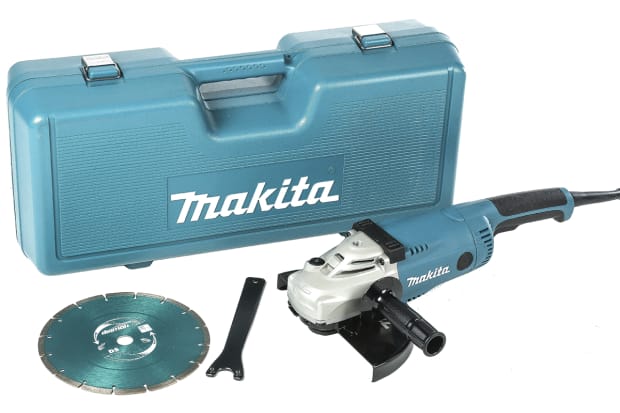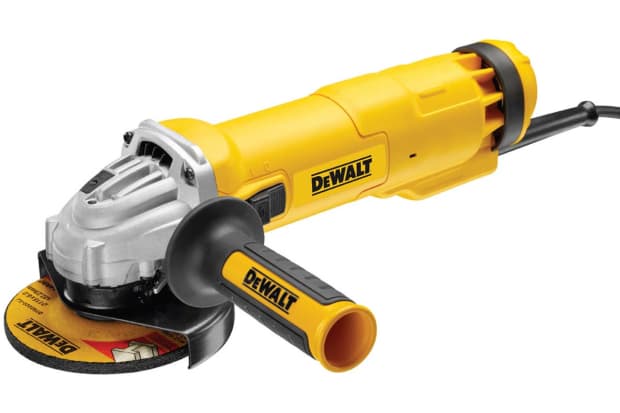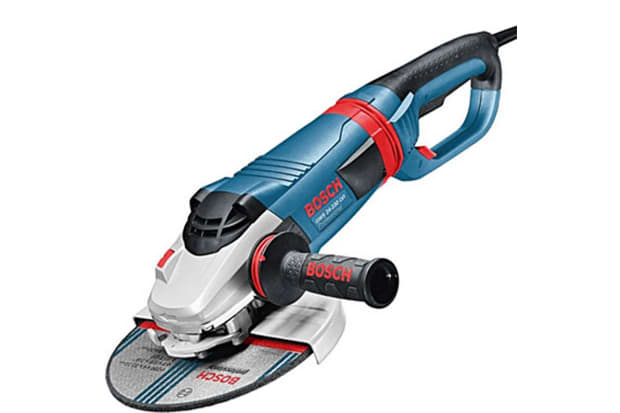- Published 30 Jan 2023
- Last Modified 29 Aug 2023
- 14 min
Angle Grinders - A Complete Buying Guide
Discover all you need to know about different types of angle grinders and learn how to use an angle grinder safely.

Angle Grinder Buying Guide
Also known as side or disc grinders, angle grinders are portable power tools specifically designed for grinding and polishing. They are used across a variety of workplaces and industries including metalworking, construction, and emergency rescue.
Power to operate the angle grinder may be generated via an electric motor, petrol engine, or compressed air. The handheld angle grinder is the most commonly used and recognised model for practical applications.
The size of the disc should have a direct bearing on your choice of angle grinder. The two most common disc sizes are 4.5” (115mm) and 9” (230mm). Grinders with larger discs are particularly well suited to heavy-duty applications, whereas those with smaller discs are ideal for finer work. Additionally, it’s worth bearing in mind that smaller grinders have a relatively high RPM and smaller discs are also more prone to wearing down quite rapidly.
The following factors should be considered when buying an angle grinder:
- Motor power
- Power source
- RPM
- Arbor size
Different Types of Angle Grinders
There are three main types of angle grinders, each suitable for specific purposes. It is important to understand the differences between each type in order to make a well-informed buying decision.
Angle Grinder Types
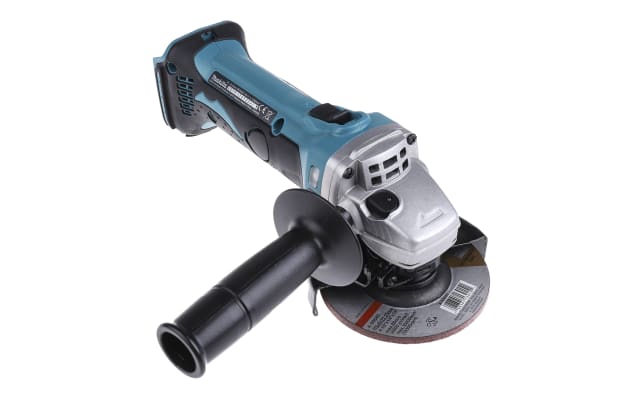
Cordless Angle Grinders
Highly practical cordless angle grinders are used across a variety of worksites. These grinders can be transported to different areas without the need for connection to power outlets. Cordless grinders are particularly helpful when it comes to the performance of ladder and scaffold-based grinding tasks as users have no need to worry about the trip hazard posed by trailing wires. However, it is advised to choose models with high capacity batteries to avoid the concern of regular mains power connection.
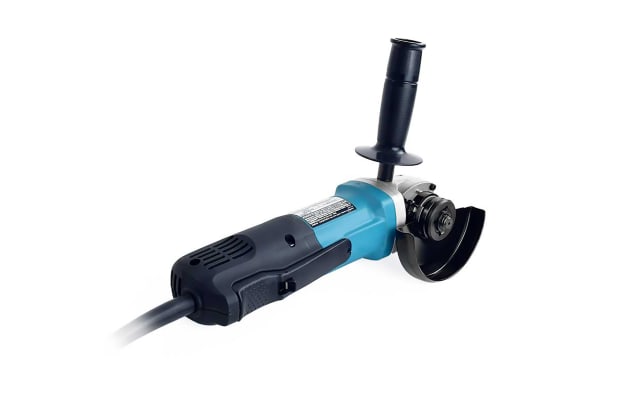
Corded Angle Grinders
The assurance of connection to a reliable power outlet will be required in some instances as it is possible to use corded angle grinders as long as they are connected to the power supply. Corded angle grinders are also typically of a lighter weight than cordless alternatives. If you are going to be using your grinder on a regular basis for minor cutting jobs, then you should opt for a model featuring a small disc. You should also account for the ergonomics and level of vibration specific to your chosen grinder.

Pneumatic Angle Grinders
Offering the ideal blend of performance and durability, pneumatic angle grinders are ideally suited to cutting and shaping metal workpieces. They are primarily used for light-duty jobs, requiring high levels of precision. Pneumatic grinders require connection to suitable air compressor units, however, they are well-suited to high-precision tasks and are considerably lighter in weight than other angle grinder models. Additionally, some come complete with throttle levers, which allow for a high level of control in the performance of technical tasks such as feather edging and speed grinding.
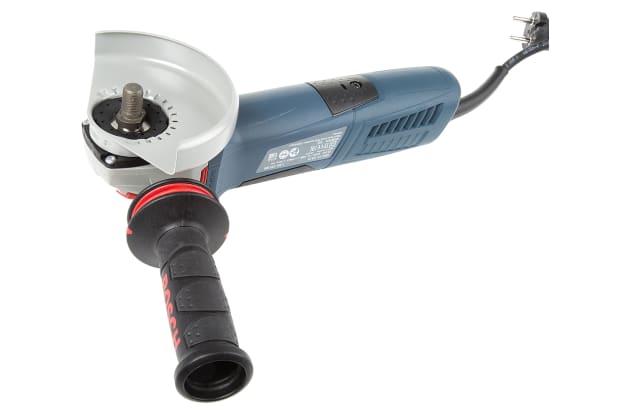
Variable Speed Angle Grinders
The discs of variable speed angle grinders can be set at different speeds to suit a wide variety of applications. The option of setting the disc at a particularly high RPM allows for the effective completion of high-precision work. Some models also come complete with paddle switches for enhanced control.
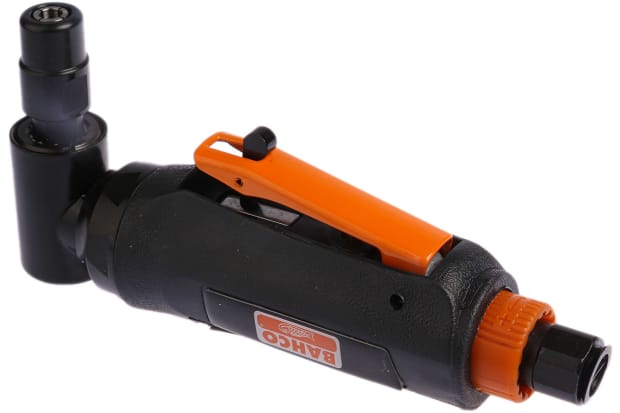
Straight Angle Grinders
The wheel of the straight angle grinder is positioned at a 90-degree angle, making this the ideal tool for grinding outer edges and inner parts of pieces, with different grinding stones attached. The unique disc angle can make straight grinders a better choice than the standard angle grinder in some instances.
What Can Angle Grinders Be Used for?
Angle grinders are most commonly purchased for the grinding of weld lumps, sharp corners, and other surfaces. However, you can also rely upon these power tools for effective sanding, allowing for the removal of old paint, spots and material defects. Alternative uses for angle grinders include the cutting of materials such as masonry tile, concrete, and metal.
Specific angle grinder uses include:
- Material finishing
- Removal of rust
- Application of matte finishing
- Blade sharpening
- Emergency rescue
How to Use an Angle Grinder Safely
Angle grinders typically incorporate a range of safety features for the effective prevention of injury. The slow start is one such feature, stopping the grinder from twisting immediately after being started. The anti-kickback is another valuable feature which ensures that the motor cuts out if the angle grinder gets caught up dangerously on any material. Restart protection will ensure that the angle grinder stays switched off in the event that it has overheated or cut out and been left with the power on. An additional safety feature is the paddle, or deadman’s switch, which ensures that the grinder only operates when held in two hands and prevents any spinning should the switch be released.
There are a variety of safety procedures which should be followed when using an angle grinder. To begin with, you should equip yourself with a complete set of personal protective equipment, including a dust mask, ear defenders, and safety goggles. The protective clothing should act as a safeguard against contact with any sparks that fly up when using the angle grinder. There should also be minimal risk of your clothes catching fire during operation.
It is expected that you will alert your co-workers and anybody else present on the worksite before you begin using an angle grinder. You should also take care to organise the wiring in order to prevent serious electrical incidents. The disc should be completely static before the angle grinder is positioned upon a surface to ensure that it doesn’t spin and cause significant damage.
These safety procedures should also be followed:
- Make sure that grinder is switched off before plugging it into a power supply
- Read and operate the grinder in accordance with instructions provided in the user manual
- Select and use the appropriate type of spinning disc for the task
- Keep the safety guard on the grinder at all times
- Use both hands for safe operation of the grinder
- Inspect the grinder before use and replace parts as necessary
- Maintain complete focus and take regular breaks
How to Choose the Right Angle Grinder
Most tasks requiring the use of angle grinders will be conducted over extended periods of time. It might be necessary to make repeated passes over the workpiece with a small handheld tool before application of the grinder. Durability will be one of the key factors and you must ensure that the appropriate amount of power is generated for the specific task at hand.
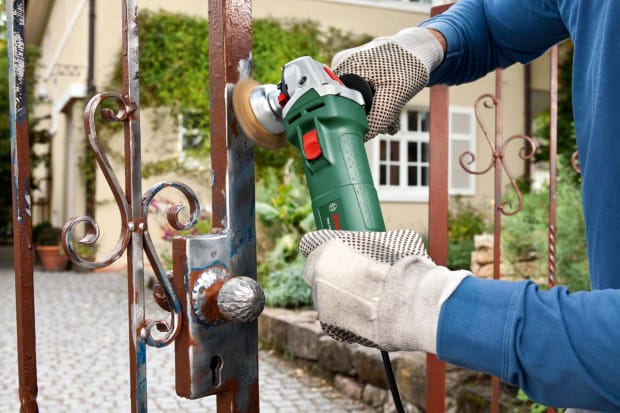
Small Angle Grinders
A small angle grinder typically has the capacity for a disc of seven inches or less. They can be used for a range of cutting and grinding purposes and are featured across a variety of angle grinders. The most commonly used sizes are the 4” and 4 ½”. These grinders typically have the capacity for wheel diameters of up to 7”, with particularly small versions having the capacity for 3” discs.
What to Look for in a Small Angle Grinder
Ideally, the small angle grinder will be fitted with a brushless motor, meaning that the brushes don’t have to be regularly replaced. The brushless motor will also allow for the efficient operation of the cordless model, minimising the build-up of heat and ensuring that the tool lasts for an extended period of time.
The kickback brake is an essential safety feature, ensuring that the wheel is stopped automatically in the event of binding. This will prevent the tool from coming free and causing serious damage. Some angle grinders are also fitted with two-stage triggers, meaning that the safety switch must be flicked to off before the trigger can set the tool into action. This minimises the risk of accidental starts associated with the changing of discs.
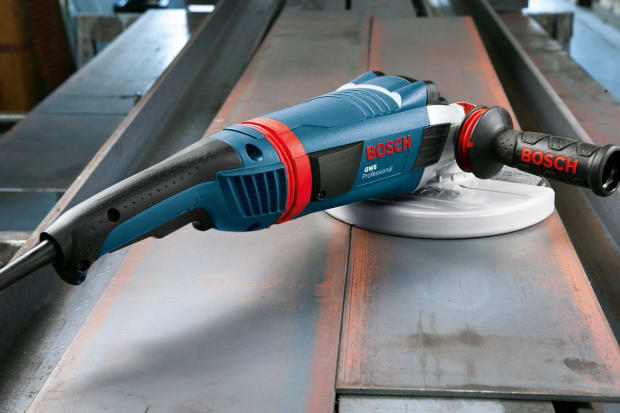
Medium and Large Angle Grinders
Angle grinders featuring 7” discs fall within the medium-size category, while those with discs between 7” and 9” are categorised as large. Large angle grinders are purpose-made for taking substantial cuts and scanning considerable surfaces in one pass. They also have particularly high levels of horsepower.
It is quite common for angle grinders in the medium-large size range to be corded. A good quality medium size angle grinder should include motors with a capacity of at least 3 horsepower (3 HP) while a large grinder would be expected to feature motors with a capacity in excess of 5 HP.
What to Look for in a Larger Angle Grinder
It is quite common for large angle grinders to feature overload protection, designed to prevent the grinder from breaking down under substantial weight. The auto shut off is another common feature which alerts you to the need for brush replacement to protect the motor. Some grinders also feature adjustable side handles which allow for a greater degree of flexibility and manoeuvrability. Additionally, there may be the option to fit a vacuum attachment for the effective collection of any dust and debris which is generated during operation of the angle grinder.
Comparing Angle Grinders
There is a selection of key factors to consider when comparing angle grinders. Read the following descriptions before proceeding to weigh up your buying choices.
Disc Size
The angle grinder disc may also be referred to as a head or wheel. There is a wide range of disc sizes available, but some of the most common sizes include 115mm (4 ½”) and 230mm (9”). The most appropriate choice of disc size will depend on the task that you want to carry out, however, you must ensure that the disc is compatible with your grinder.
Power of the Grinder
Angle grinder wattage (W) is specific to the amount of power which is generated. The required wattage level will depend on the size of the discs. The input power of a corded model will be rated in terms of amps (A), with the corresponding input for cordless models being rated in terms of volts (V). The input of pneumatic angle grinders is presented in terms of CFM (cubic feet per minute) and there is typically a corresponding pressure in pounds per square inch (PSI).
Speed of the Wheels and Discs
You should be aware that angle grinders with the capacity for small discs generate a higher RPM than larger models. It is common for the rotations per minute (RPM) to be expressed in terms of ‘no-load speed’, which is equivalent to the fastest rotation without a disc being installed. A medium-sized angle grinder is expected to go faster than 8,000 RPM, while a larger angle grinder may generate around 6,000 RPM. However, the larger angle grinder will have far more power.
Different Wheels and Disc Types
Silicon Carbide Grinding Discs
These discs are purpose made for the shaping of metals. They also allow for the efficient removal of materials and prevention of surface damage. Use of the grinding discs is expected to minimise the need for subsequent processing, allowing preparation time to be saved.
Cutoff Grinding Discs
These discs are purpose made to cut hard items and materials such as rods, bolts, rebars, and metal piping.
Sanding Pads and Discs
Sanding pads allow for the efficient removal of old paint in the process of surface preparation. They are also suitable for coarse and fine sanding.
Grinding Wheels and Discs
The grinding wheel is an expandable wheel, made from an abrasive compound. It allows for a variety of grinding and abrasion functions. Grinding wheels and other forms of bonded abrasives have two key features – the abrasive grains which allow for efficient cutting, and the bond which combines and supports the grains during the cutting process.
Grinding discs are suitable for metal and stone applications across a range of machine sizes. The main use of such discs is in the removal of materials. However, they can also be used for the finishing and preparation of stone and metal surfaces.
Wire Brush Wheels
These wheels allow for the effective removal of paint and rust. They also enable the removal of burrs from rough-cut metal surfaces.
Diamond Cutting Wheels and Discs
These wheels and discs are particularly suitable for the cutting of concrete, tile, masonry, and granite. However, it is important to make the appropriate selection and use of the cutting blade in accordance with the technique. There are diamond blades suitable for dry and wet cutting.
Aluminium Oxide Grinding Wheels
These oxide-based wheels are suitable for a wide range of applications, including woodworking and the cutting of crumbly materials like cutting boards.
Flap Discs and Wheels
The flap disc performs a similar function to the wire brush yet features flaps rather than wires. This allows for the effective combination of weld beads with the rest of the metal.
FAQs
What are the Most Popular Angle Grinder Brands?
There is a wide variety of angle grinders available, with models suitable for amateur and professional purposes. You can choose from tools for specific applications such as cutting, polishing and grinding, but it is important to select the angle grinder which is best suited to your intended use.
Some of the most popular brands include:
- Dewalt
- Makita
- Bosch
- Hitachi
- Black + Decker
Can You Get Battery Operated Angle Grinders?
As previously mentioned, there is a great selection of cordless angle grinders which run on battery power. You can browse our full range of cordless angle grinders to discover the best model to suit your requirements.
How Do You Fit a New Angle Grinder Disc?
It is essential that you disconnect the angle grinder from the electric power supply prior to fitting the disc. You should then press the spindle lock button and nudge the disc until it fits securely in place. The spindle lock button should be held while you remove the clamping flange, which is then attached so the flat surface comes into direct contact with the disc. A wrench may be used to tighten and firmly secure the flange.
What is the Difference Between an Angle Grinder and a Disc Cutter?
The versatile, durable angle grinder is suitable for applications such as cutting, grinding, polishing and sharpening. Conversely, the disc cutter is a small, single-handed cutting blade which is best suited to light cutting applications. The angle grinder is typically heavier and requires some strength to control, while the disc cutter is lighter weight and offers greater manoeuvrability.
What Will Break an Angle Grinder?
No matter the angle grinder that you are using, there will always be a risk of breaking the abrasive wheel. However, it is possible to minimise this risk by checking the discs, ensuring the correct mounting, and following the safety procedures. It will also be necessary to mount the abrasive wheels correctly on the corresponding tool.
Angle grinder damage may also occur as a result of kickback. This can happen when the grinder jams with the material being cut or shaped and is more likely to occur if you are using the incorrect wheel or cutting at an inappropriate speed.
Can You Cut Through Metal with an Angle Grinder?
A high-powered angle grinder can be used to cut through any type of metal. However, there will be a risk of flying sparks and debris when cutting different types of metals. It will be necessary to wear goggles and other types of personal protective equipment during such activities.
What Materials Cannot Be Cut by an Angle Grinder?
A high-powered angle grinder will be able to cut through the vast majority of materials. However, diamond and multi-layered materials have a high level of cutting resistance. You should always use an angle grinder in accordance with the manufacturer’s instructions and only perform grinding tasks if you are completely confident and assured of safety.
